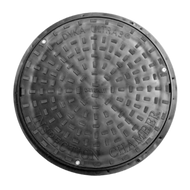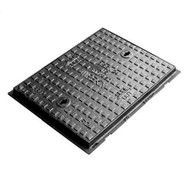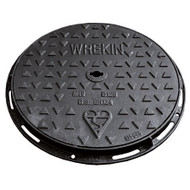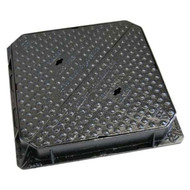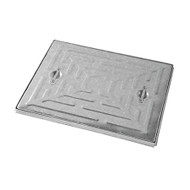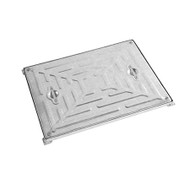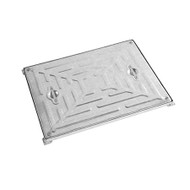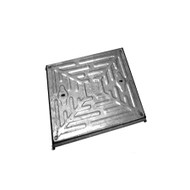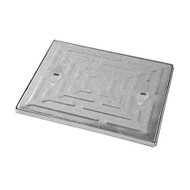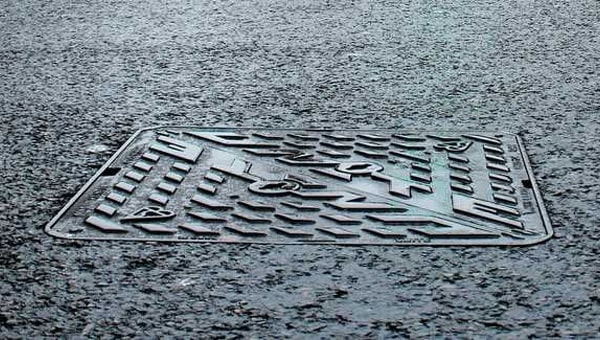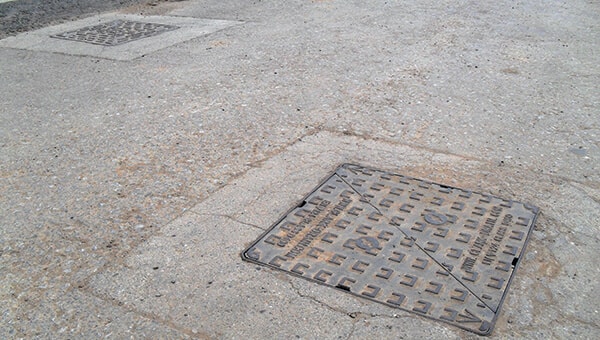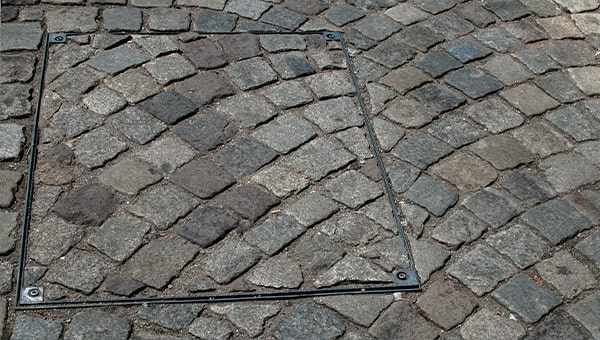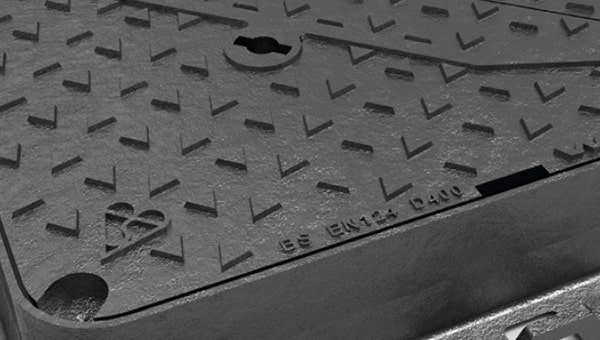Manhole and access covers are manufactured in various shapes, sizes and materials to suit every need. The importance of choosing the right one cannot be understated, as choosing an unsuitable cover for your application can have significant safety and security implications. Deciding which cover is right for you can seem like a daunting task... but it doesn’t have to be!
The key is in understanding your application and being able to answer the following questions:
- What size do I need?
- What weight loading should it be?
- What type of cover do I want?
- What type of seal should it have?
As you go through this list the choice of cover may be determined for you. For example, if you're looking for a cover in a highway, you can only use cast/ductile iron BS EN 124 covers instead of a steel cover.
We've put together the following information where we'll cover (pun intended) the most common options available and offer advice how best to answer these questions.
What is a manhole or access cover?
Let's start with the basics: there is a difference between a manhole cover and an access cover.
All manhole covers are technically access covers (in that they restrict access to a drainage system/manhole) and are usually cast or ductile iron, and access covers tend to be steel, aluminium or a composite material, but not all access covers are manhole covers. They also both have different standards they comply with.
To cover the complexity of whether eggs are eggs we've got a dedicated overview of the differences between manhole and access covers to help answer which type of cover you need.
How do you correctly measure the size?
Covers are manufactured and listed by their clear opening size, which is the size of the manhole itself, and not the dimensions of the cover. Because the cover must sit securely the clear opening size is the crucial measurement to you need to take. It is typically measured in millimetres (mm) and can either be square (e.g. 450 x 450mm), rectangular (e.g. 450 x 600mm) or circular (e.g. the diameter - 450mm).
To measure the clear opening size for your cover you need to take the measurements from the inside walls of the manhole, from one side to the other. If the hole is square or rectangular, you will need to take both the width and height measurements as opposed to just the width/diameter of a circular one. You will also need to measure the depth of the brickwork/asphalt that the cover will be sitting in, known as the frame depth, to ensure you get the most accurate measurement possible.
What weight loading do I need?
Now you know what size of cover you need the next big decision to make is the load rating required for your application.
For BS EN 124 covers the standards range from class A15 (very light duty) to F900 (extremely heavy duty). Each loading application has a specific meaning, and a minimum requirement for each group, and it's important that the right one is chosen otherwise the cover will not last and its safety and security will be compromised. It'll also need a pretty expensive repair job. Do it right — do it once.
BS EN 124 Load Classifications
| Loading Group | Minimum Class | Suitable Installation Area | Maximum Test Load |
|---|---|---|---|
| Group 1 | A15 | Pedestrian areas & cycle paths with no vehicle access | 15kN (1.5 tonnes) |
| Group 2 | B125 | Domestic driveways & pedestrian areas with infrequent vehicle access | 125 kN (12.5 tonnes) |
| Group 3 | C250 | Car parks and areas of slow moving traffic. Also for gully gratings in certain carriageway areas | 250 kN (25 tonnes) |
| Group 4 | D400 | Main roads and motorways that are heavily trafficked at high speeds | 400 kN (40 tonnes) |
| Group 5 | E600 | Heavy duty areas such as warehouses & docks | 600 kN (60 tonnes) |
| Group 6 | F900 | Extremely heavy duty areas such as airports | 900 kN (90 tonnes) |
These covers tend to be manhole covers made of cast/ductile iron. Find out more about the groups and classes of the BS EN 124 standard to determine whether this suits your application.
FACTA Load Classifications
| FACTA Class | Historical GLVW Description | Historical Load Description | SMWL Pneumatic Tyres | SMWL Solid Tyres |
|---|---|---|---|---|
| A | 2.5 tonne | Pedestrian | 0.6 tonne (5kN) | - |
| AA | 5 tonne | Domestic Light Duty | 1.5 tonne (15kN) | - |
| AAA | 10 tonne | Light/Medium Duty | 2.5 tonne (25kN) | 0.5 tonne |
| B | ≥ 25 tonne | Medium Duty | 5 tonne (50kN) | 0.75 tonne |
| C | ≥ 38 tonne | Medium/Heavy Duty | 6.5 tonne (65kN) | 1 tonne |
| D | ≥ 44 tonne | Heavy Duty | 11 tonne (108kN) | 3 tonne |
| E | Special application vehicles | Forklift/Docks | 16 tonne (158kN) | 5 tonne |
| F | Special application vehicles | Airport | 24 tonne (237kN) | - |
The FACTA standard is usually applied to access covers that are made of steel. You can't use these in heavy trafficked areas where speeds are greater than 20mph.
What type of cover do I need?
Knowing the size and load class of the cover you need will help narrow down the options available, but you'll still have a couple of decisions to make. There are many different types of cover available and many different materials from which they can be made. Below, we’ve put together a list of the common ones you’ll see when looking around to help you understand the best options available for your project.
Solid or recessed top?
Solid top covers are the standard everyday cover, fit flush to the surface, and are very visible. You'll be able to see markings such as the kitemark, BS EN 124 or FACTA classification, the manufacturer and sometimes what service lies below (such as water, sewage, CCTV etc.).
Recessed covers have a sunken tray that allows for block paving, screed, or other materials laid within helping to camouflage the cover into its surroundings. You'll typically only see the outline of the cover in the ground, and you'll notice these in pedestrian areas on high streets and in shopping centres (where a cast/ductile iron cover would stand out too much).
Cover materials: cast/ductile iron, steel, or polypropylene?
- Cast/ductile iron covers are the strongest, most resilient covers available, able to carry maximum weight loads of up to 90 tonnes. Of the two ductile iron is often considered the superior choice, since it is less brittle, and doesn’t corrode as quickly as cast iron. Covers made from ductile iron also have a greater strength to weight ratio than their cast iron counterparts making them safer to handle and install.
- Both types of iron covers are used to manufacture manhole covers suitable for each of the classes rated by the BS EN 124 standards and are ideal for high speed, highly trafficked areas. However, they can be a bit overkill in lightly trafficked or pedestrian areas.
- Galvanised & stainless steel covers covers are a lightweight, yet surprisingly strong, alternative to iron covers. They are easy to install and are typically able to withstand up to 17 tonnes of weight, making them ideal for domestic driveways. However, they are not suitable for high speed, heavily trafficked areas such as main roads and motorways. Steel covers are also more commonly rated with a FACTA loading class.
- Polypropylene covers are typically only used in ‘light duty’ load bearing areas such as gardens, pedestrian only walkways or domestic driveways. They make ideal covers for PPIC chambers.
There are some other types of material you may see, such as aluminium used for recessed covers, and even composite materials such as an iron cover/polypropylene frame that offer benefits of both materials, but the ones mentioned above are the most common. When it comes to choosing between them the most important thing to consider is the weight bearing that is required and that the loading is at least the minimum required for your application.
What type of seal is best?
Size: check. Loading requirements: check. Type of cover: check. Chances are your cover choices are now limited to a select few covers that suit what you're doing — but what is this seal thing all about? Does it really matter? It's certainly not as important as the size or loading, but knowing the differences in seals might sway your decision on what cover you buy.
- Unsealed/no seal covers means there's no seal between the cover and frame, and the cover simply slots into place. Often called "plain seated" these covers are not airtight and are unsuitable for applications such as drainage systems where bad smells may be present. Where the cover is for utilities or cables, unsealed/no sealed covers could save costs.
- Single seal covers have a tongue and groove joint that creates an airtight seal between the cover and frame. Most standard covers are manufactured with a single seal and it can help to prevent the egress of odours and ingress of water when the sealing groove is filled with grease, or a single rubber ‘O’ ring, making them ideally suited for drainage manholes.
- Double seal covers have a double tongue and groove joint. They work better at preventing air/odours from escaping but only providing the manhole is not under pressure. This kind of seal is often used when foul drainage manholes are situated within buildings.
This choice largely depends on the application you have. If you need to keep foul odours from escaping, you definitely need a sealed cover. Whether you go with a single or double though will depend on if the cover will come under pressure.
Sometimes, however, the choice of seal might have already been made for you. If you need a D400 ductile iron cover for a highway, for example, double triangular models are often the best. These covers are only available unsealed as each triangular lid only sits on the frame in three places, making a seal impossible. Slide-out covers are also only available unsealed.
What's the right cover for me?
Know your size, know your loading, and pick your type and your seal. Choosing a new manhole cover, or replacing an old one, can be that simple. The key is all in the knowledge. Hopefully, if you have followed this guide, that knowledge should now be at your disposal.
A common pitfall is tor underestimate the potential loads your cover may have to withstand. If you need a manhole cover in your garden, for example, then a solid top A15 polypropylene one will suit the job. If you need one for your driveway, you’ll need one with a higher load class that’s made from a more durable material; a steel cover with a FACTA AA rating or an iron cover with a B125 rating would suit... but remember to take into account the maximum loading that could be expected in that area — a caravan or motorhome might need a heavier load cover.
If you want your cover to blend in to the surrounding area, then a steel recessed one might be best, but only if it is in an area of low intensity traffic where speeds do not exceed 20mph. For high intensity areas, where traffic does exceed these speeds, your only choice of material will be between cast iron or ductile iron, as none of the other types will be safe for use.
The golden rule to follow is, if in doubt, always go for the higher rating. It is far better to overestimate than underestimate the loading requirement when it comes to manhole covers and access covers.
JDP offers a wide range of manhole and access covers, available across our site and throughout our branches, to suit most applications. And, as ever, our team is always ready to answer any of your questions and offer advice if you need any help choosing the right one for your project.


